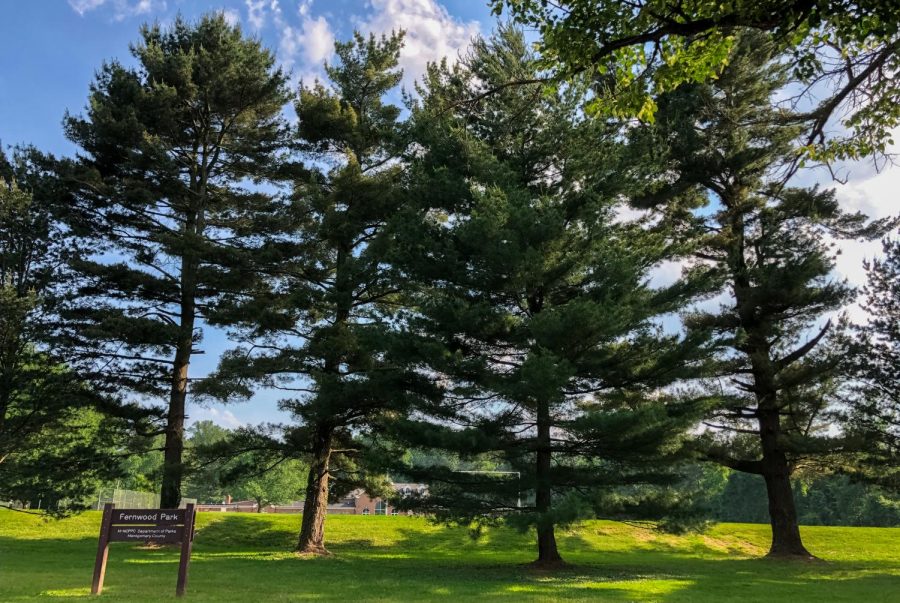Branching into a new hobby: The art of tree climbing
Photo courtesy of Alex Schupak
Four pine trees at Fernwood park. A storm knocked down the tree second from the left two days after I climbed it.
June 27, 2020
With Tyler the Creator’s Igor blasting through my earbuds and the orange light of the summer sunset warming my face, all my worries seemed to drift away; this was the highest I had ever been. Two days later, the 80 foot pine tree that I was so proud of summiting lay strewn across the neighborhood park, an awe-inspiring spectacle for any passerby. Dead or alive, the tree had an allure that captivated both myself and rubberneckers to investigate its canopy.
Tree climbing is not a sport you’ll find on ESPN. Some might not even call it a sport at all. Nature enthusiasts have overlooked scaling trees in favor of its more popular counterpart, rock climbing. But last summer, I gained a newfound appreciation for an activity that most people pay no mind to—an activity I had last tried in elementary school.
My journey into tree climbing started at an MSI soccer game in first grade. I don’t remember much from that day, except for my teammates’ cheering, a bucket of ice pops and the distinct feeling of accomplishment after clambering up a cherry blossom. The climb introduced me to a hidden world atop branches, tucked away from the commotion of daily life. Until last summer, this experience had been buried in the depths of my mind.
After all those years, my tree climbing saga resumed. It was late May. I was in my friend’s backyard, listening to music and playing basketball, when I noticed an adolescent beech tree, no taller than a house. Its straight and sturdy features piqued my interest, and I began to scale its branches on a whim. As I reached the top, I rediscovered the adrenaline rush of being so close to danger, with the added reward of getting a birds eye view of my world. It was liberating. Over the next year, I perfected my craft for consistency and success. As with all niche hobbies, sometimes it can be difficult to know where to begin. Here are a few tips I’ve come up with which all prospective tree-climbers should consider.
Tip 1: Look up
Tree climbing is not complicated. Trees are like ladders; you can just move one foot with the opposite hand. Climbing experience and athleticism are not necessary to start. There is a tree for everyone, at all skill levels. Walk around your neighborhood until you find something that fits your comfort range.
Tip 2. Know your trees
The most obvious division in tree climbing is the deciduous/coniferous split. Deciduous trees are seasonal and flowering and coniferous trees are evergreen and cone bearing. Beginners should look for deciduous trees, due to their short stature and smooth bark. However, they tend to be full of misshaped branches at awkward angles, making the path to the top fairly confusing.
More advanced climbers might prefer the coniferous variety. Their bark is more serrated and the exposed trunk will make anyone feel uneasy about the precarious footholds. The silver lining is that the limbs are always at precise right angles from the trunk, leaving a clear path to the top.
Beside tree characteristics, it’s also important to become familiar with the various plant and animal species that live in trees so you can be prepared for any unexpected challenge — or surprise visitors — that you might find.
Tip 3. Climb at the right time
Tree climbing season starts when the first leaves burst out of their buds and ends when they start changing colors. This information is crucial; you must know the difference between a living branch that will support your weight and a dead branch that will snap with more than five pounds of added pressure. The simplest way to classify a branch is through leaf growth; living branches have green leaves and dead ones are barren.
It’s important to climb at both the right time of day and the right time of year. Summer is the best season for climbing. The sun will illuminate your path through the shadows of leaves. As a safety precaution, bring a friend along with you; if you fall out of a tree and no one hears or sees you, did it even happen?
Tip 4. Protect yourself
No matter how careful you are, without proper equipment, you will get scratched up by the tree. It’s the ultimate paper cut. Even in the sweltering summer heat, I recommend both long-sleeved shirts and pants to protect your arms and legs from the jagged bark.
Your hands are an even more important instrument to protect. Since they are in constant contact with the bark, your hands are the part of your body most susceptible to damage. This makes gloves a necessity. Personally, I find batting gloves to be the best pick for their flexibility and durability.
Tip 5. Try to land on your feet
There is nothing worse than sliding down 13 feet of jagged tree bark, wearing nothing more than a t-shirt, shorts and shoes, as you scream for your brother’s help. I speak from experience. It was so horrifically memorable that I wrote a narrative about it six months later in my English class. After the incident, I took a couple weeks off from climbing to recover and understand my mistakes. Once my injuries healed, I just went back out and started practicing on small oak trees. In no time, I was back to my prior tree-climbing glory.
I can recall nearly every time I’ve ascended a tree in the past year so vividly that they now work as timestamps for my life. Through my highs and lows, the rewards of tree climbing never seem to dull. With an abundance of free time these days, it’s important to find a hobby or activity that is fulfilling, interesting and gets you outside. And for me, that’s tree climbing. Are there other things you can do with this time? Absolutely. But why would you, when your next adventure lies no further than your neighborhood park?







